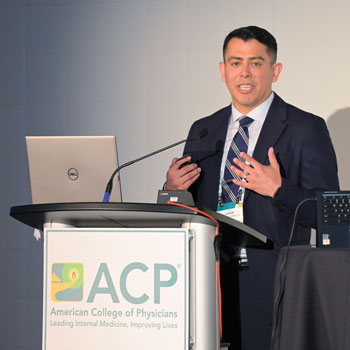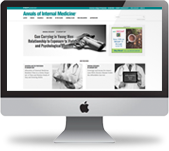Optimizing clinical reasoning during the diagnostic process
When presented with a challenging patient case, physicians should ask themselves ‘what fits, what doesn't fit, and what's missing,’ experts explained.
Physicians may not often think about how they think, but that's what panelists challenged attendees to do at a session on improving clinical decision making at Internal Medicine Meeting 2025.
During the presentation, ACP Member Katie Gavinski, MD, MPH, MS, Melissa McNeil, MD, MPH, MACP, and Eliana Bonifacino, MD, MS, described how clinicians typically think, identified mistakes made during the diagnostic process, and laid out strategies to combat errors in medical reasoning.

“This is incredibly important, because when we try to estimate how good we are at making diagnoses, which is incredibly hard to do, it turns out we're not as good as we think,” Dr. Gavinski, an assistant professor at the Medical College of Wisconsin in Milwaukee, told the packed room.
“Some studies estimate that the rate of diagnostic error [is] somewhere between 10% to 15% of encounters,” she continued. Although physicians may assume errors are the result of faults in their knowledge base, in reality, “the key factor is how we synthesize and put together information.”
Breaking down the thinking
Dr. Gavinski walked physicians through differences between intuitive and analytical reasoning, stressing that “both are absolutely essential to our decision-making process.”
Intuitive reasoning tends to be automatic, reactive to an already learned heuristic or pattern. Because it's a quick decision, intuitive reasoning is also more prone to error. Analytic reasoning is much slower, deliberate, and cognitively taxing and is most useful during complex cases, Dr. Gavinski said.
She noted that clinicians use intuitive reasoning about 95% of the time and typically automatically adopt intuitive reasoning or analytic reasoning depending on whether they recognize patterns in a patient's presentation.
But physicians can also switch between the two types during the six-step diagnostic process: data collection, data organization, problem representation, generation of diagnostic impressions (and a differential diagnosis), comparison to known illness scripts, and selection of diagnosis.
It's also important to be alert for biases. “When these kinds of heuristics and patterns fail us, we can end up with this cognitive bias” related to emotions, physicians' perception of their own skills or those of others, or estimations of probability, warned Dr. Gavinski.
Dr. McNeil, a professor of medicine at Brown University, offered some tips for transitioning from intuitive to analytic reasoning.
“I certainly ask my housestaff, I try to ask myself as well, ‘What fits? What doesn't fit? What's missing?’ Those three questions are so helpful to me as my check at the door to know when I have to kick to [analytic reasoning],” she said. “When your initial diagnostic inclination doesn't seem to be working, you have to go back to the starting gate.”
When confronted with a confounding case, “I focus on the finding that is the most unusual, most different, and/or has the narrowest differential,” she said. The speakers also offered case studies, and she pointed to one of them as an example, noting that while nausea, vomiting, and fatigue are common symptoms, this patient also presented with hyperkalemia. “That's not a very big diagnosis.”
On the other hand, physicians are typically taught to not look for zebras in every case, she noted. “The challenge … is having some sort of rapid-fire system in place. [The three-question model] gives you the checklist so you know when to switch from the horse to the zebra.”
Thinking through medical errors
The speakers offered several steps physicians can take to think their way away from medical errors. The first is to deliberately and consistently engage in the diagnostic process, said Dr. Bonifacino, an assistant professor at the University of Pittsburgh.
She called attendees back to the six-step diagnostic process to elaborate on two areas prone to medical error: problem representation and comparison to known illness scripts.
Problem representation is the mental model of a presentation that forms in physicians' brains when they see a patient, including history, current presentation, labs, and diagnostics. This idea is often conveyed in a summary statement that provides a clinical context, a temporal pattern, and key clinical findings.
“This sounds very academic for something that you're already doing,” she said. However, when Dr. Bonifacino and colleagues researched differences in problem representations by experts versus novices, they found that “more junior clinicians were more likely to include more comorbidities and irrelevant comorbidities” than experts.
Their research, published by the Journal of Hospital Medicine in March 2024, also showed that around 25% of novices and 14% of experts included inaccuracies in their summary statements. “There was no difference in those two groups in diagnostic accuracy, but what was associated with better diagnostic accuracy was adhering to that three-part structure that I talked about, and including a temporal semantic qualifier,” Dr. Bonifacino said. These are words such as “acute,” “generalized,” or “severe,” which help transform data into meaningful abstractions, according to the researchers.
Physicians may be less familiar with the “known illness script” step in the diagnostic process. Dr. Bonifacino explained that it includes “the information in your brain about a disease … who gets it, the temporal pattern, the symptoms, and physical exam.” The problem representation encompasses the patient's presentation, and the illness script covers the disease. Part of the diagnostic process is “comparing your problem representation to your flashcards of illness scripts that you have in your brain,” she said.
She encouraged attendees to think about ways to improve their own illness scripts in clinical practice, like familiarizing yourself with atypical presentations of typical diseases.
These processes won't always get you to a diagnosis in a single visit, Dr. Bonifacino noted, emphasizing the need for diagnostic feedback.
“Encourage your trainees … to have a list of patients that had outstanding issues or diagnostic uncertainty, so then you can find a way to follow that up and learn from it,” she said. Communicating with peers and asking for confirmation of a diagnosis can also be useful.
Receiving feedback can be uncomfortable, “but we all deserve to know when our reasoning could have gone better,” Dr. Bonifacino said. You can also do the same for others. When something turns up, “it's not that your colleagues are wrong, it's not that the tests are wrong. It's that disease courses evolve,” she said.
Her final take-home points included some red flags that can identify when the diagnostic process has fallen short. “That could be the patient doesn't progress as we expect based on the diagnosis,” a readmission, or discordant information that doesn't fit the working diagnosis, she said.
“The clinical reasoning process constantly evolves. More information is available. We have more history, we have more labs. And so this is a process, an iterative process, that we go through, and so having these hard stops to reconsider our [diagnosis] is really important,” she concluded.




